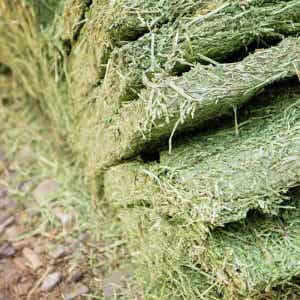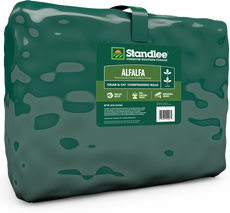At Standlee Premium Western Forage, we are driven to succeed by being relentless in our efforts to provide the highest quality premium western forage. We pay attention to the details and our quality assurance program is in place to do just that.
The Standlee Difference starts in the fields where our farm managers are extensively involved with the process, ensuring all quality standards are met from the start. Once our premium western forage is baled and inspected, we take extra care that it stays that way by utilizing fully enclosed tarps, protecting the forage from the start. Throughout Standlee Premium Western Forage's processing lifecycle, quality testing is performed to ensure our products meet or exceed expectations.
The Survey

Alfalfa forage is typically more palatable and preferred by horses than other grass forages, and this study demonstrated that horses found Standlee alfalfa highly palatable. This study's objective was to test the hypothesis that Standlee alfalfa measured higher in quality indicators than locally sourced hay.
The majority of survey participants indicated that the appearance of forage is indicative of nutritional quality. When evaluated by itself, the participants felt that Standlee alfalfa was a very high quality product and it scored very high on all aspects evaluated.
Six Signs of Good Quality Hay
To set the stage, Purina published the “Six Signs of Good Quality Hay.” In summary, the following key visual indicators help horse and livestock owners select the best quality forage for their animals:
- High Leaf-to-Stem Ratio
- Small Diameter Stems
- Few Seed Heads or Blooms
- Fresh Smell and Appearance
- Cleanliness
- Hay Color
Survey Results
For all qualitative surveys, locally sourced alfalfa was classified as Hay A, while Standlee alfalfa was classified as Hay B. For all parts of the survey, the respondents were asked to rate several statements based on the following scale: Strongly Disagree, Disagree, Neutral, Agree, or Strongly Agree.
A portion of the survey asked respondents to evaluate Standlee alfalfa (Hay B) based on different appearance characteristics. The statements that were analyzed are as follows with the number of respondents selecting agree or strongly agree in parentheses:
Appearance
Based on the overall appearance of Hay B, I believe it has a high nutritional value
Smell
Based on the scent or smell of Hay B, I believe it has a high nutritional value
Color
Based on the color of Hay B, I believe it has a high nutritional value
Texture
Based on the texture of Hay B, I believe it has a high nutritional value
Contents
Based on the contents of Hay B, I believe it has a high nutritional value
Moisture
Based on the moisture content of Hay B, I believe it has a high nutritional value
Standlee Alfalfa Comparison

When survey participants compared the two alfalfa sources, Standlee alfalfa consistently scored higher than the locally sourced alfalfa in all categories, specifically related to the texture and stem length. Overall, horse owners believed that Standlee alfalfa was of higher nutritional quality and was preferred by the participants over the locally sourced product.
Featured Alfalfa Products
Claims are based on joint studies between Standlee Premium Western Forage and Purina Animal Nutrition in 2016 & 2017. A veterinarian should evaluate changes in diet before implementation. Claims not verified by AAFCO. Claims are intended for informational use only and should not be considered as healthcare advice, veterinary or medical diagnosis, treatment, or prescribing of any kind. Proper medical assessment and veterinary recommendation should be obtained before making any changes to your animal’s diet.





